and Silvio Mazziotti1
(1)
Department of Radiological Sciences, University of Messina, Messina, Italy
Abstract
In this chapter numerous entities are discussed which can be characterised by a significant clinical impact or conversely are detectable through the alteration of the masticatory apparatus’ normal functionality such as tooth anomalies which are correlated to errors of the development of the tooth itself and alterations of number, position, morphology, width and structure.
This chapter includes numerous entities which can be characterised by a significant clinical impact or conversely are detectable in a functionally normal masticatory apparatus.
Of particular concern is the topic regarding the tooth anomalies which are correlated to errors of the development.
The field also comprises alterations of number, position, morphology, width and structure.
Number Anomalies
As previously explained, in the adult there are 32 permanent teeth. These are preceded by the 20 deciduous dental elements in evolutionary age subjects.
A number anomaly can occur in defect (hypodontia), in case of one or more teeth missing (agenesis) and in excess (hyperdontia), for the presence of one or more supernumerary elements.
Agenesis can be detected both in adult and paediatric age subjects.
However, in both cases, it is related to permanent dental elements.
Agenesis is a quite frequent event when limited to one or more dental elements; conversely, total agenesis or anodontia turns out to be extremely rare.
The dental elements affected by such anomaly are the second premolar teeth, the lateral incisors teeth and the third premolar teeth (Figs. 3.1, 3.2 and 3.3).
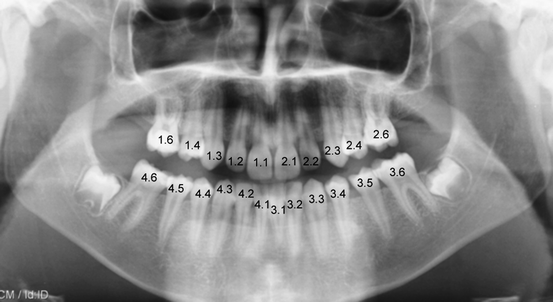
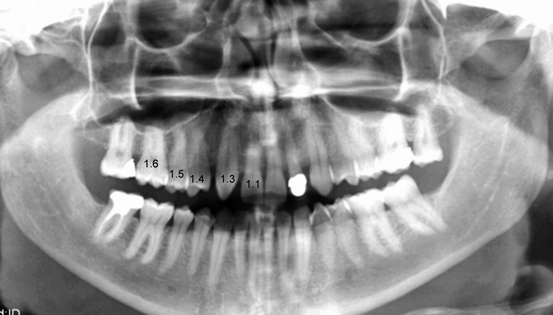
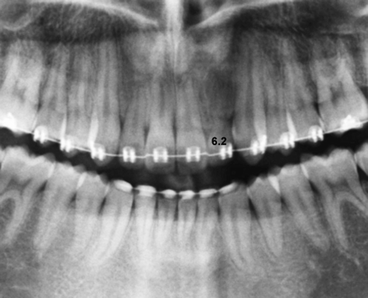

Fig. 3.1
Agenesis of 1.5 and 2.5. The permanent dental elements of the inferior arcade show normal anatomy

Fig. 3.2
Agenesis of 1.2

Fig. 3.3
Agenesis of 2.2 with persistence of the corresponding deciduous element (6.2)
Dental agenesis, while more often detected in adults, is more important to be radiologically diagnosed in paediatric age subjects. In the latter, in fact, if a permanent dental element is clinically recognised as missing, the differential diagnosis includes both agenesis and a possible delay or missed tooth eruption. This may lead to the inclusion of the tooth (Figs. 3.4 and 3.5).
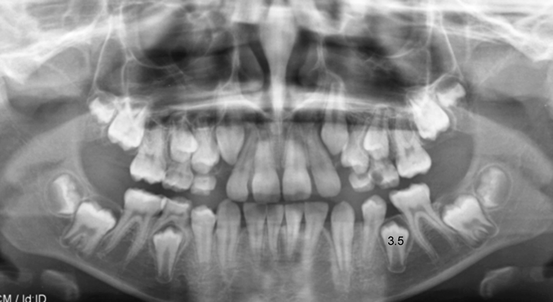
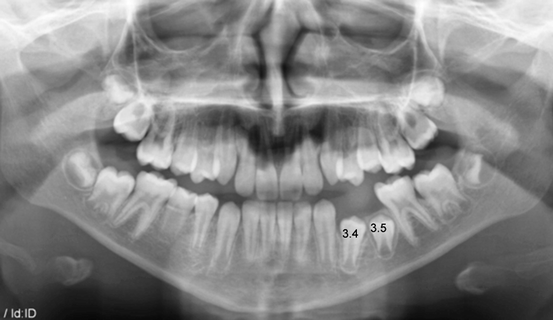

Fig. 3.4
The dental element which is not visible is not agenic but inclusive

Fig. 3.5
3.4 and 3.5 are not visible under inspection as they are inclusive and not agenic
Another important point which can only be clarified radiologically is represented by the persistence of a deciduous element which is associated to the agenesis of the corresponding permanent dental element or to the presence of an inclusive permanent element (Figs. 3.6 and 3.7).
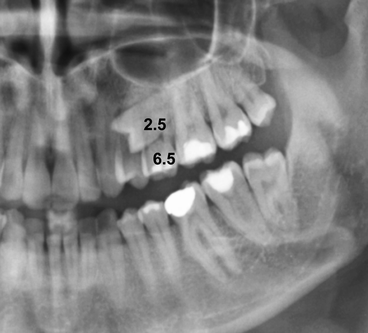
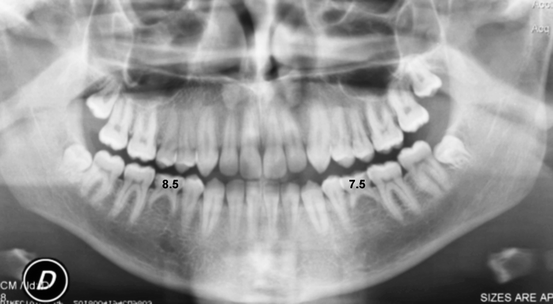

Fig. 3.6
Persistence of the deciduous element 6.5 with inclusion of the element 2.5 in mesiodistal angulation. The enlargement of 2.5 indicates that the latter is farther from the detection plane with respect to the adjacent elements (therefore it is located in palatal seat)

Fig. 3.7
Persistence of the deciduous elements 7.5 and 8.5 with agenesis of the corresponding permanent elements
However, particularly in the adult subject, the diagnostic finding regarding the lack of a dental element is fundamentally supported also by the anamnestic-clinical criterion. Sometimes, the radiographical characteristics of an extraction site can be useful to orientate the differential diagnosis between agenesis and the results of a previous dental avulsion (Fig. 3.8).
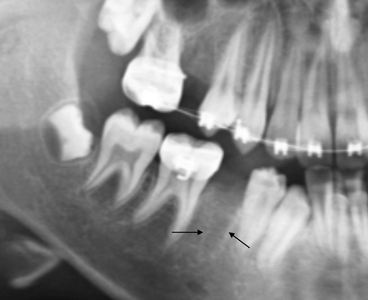

Fig. 3.8
The element 4.5 is not represented. The presence of the extraction site’s vestigia (arrows) allows us to exclude agenesis
Structures of odontogenic origin must not be considered in the field of supernumerary teeth. These structures are often contained in maxillaries, which are in surplus when compared with the normal dental elements. However, due to their particular morphological characteristics, they are included in the topic of odontomas, which will be discussed in a later chapter.
The presence of supernumerary elements can pertain to the permanent dentition and, more rarely, to the deciduous one, with their prevalence in the superior arch (Fig. 3.9).
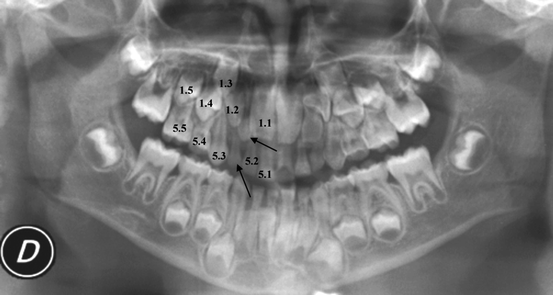

Fig. 3.9
Six deciduous and six permanent elements are detectable in the superior right hemiarch. The arrows indicate the surplus elements. A similar situation occurs in the superior left hemiarch
Although the phenomenon can occur in extremely variable and unpredictable ways, it must be noted that some of its manifestations turn out to be typical and well recorded clinically.
These manifestations include the so-called mesiodens. This is a small dental element, sometimes rudimental, typically situated between the central incisors in the median or paramedian region. It is characterised by a conoid or caniniform aspect (Figs. 3.10, 3.11 and 3.12).
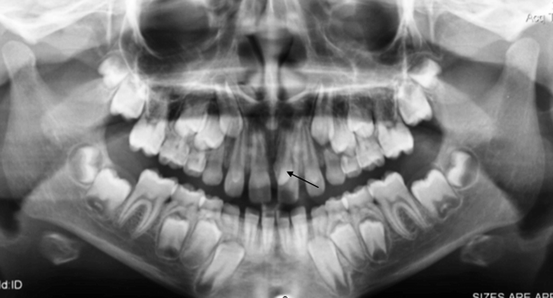

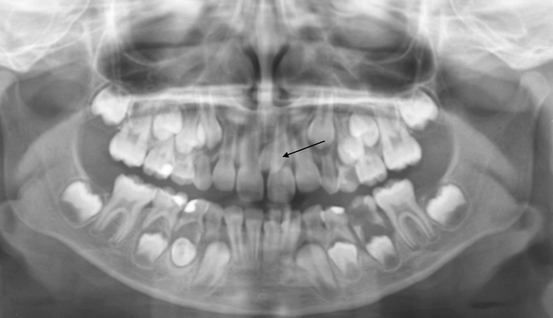

Fig. 3.10
Supernumerary caniniform element (indicated by arrow) between the superior median incisors (mesiodens)

Fig. 3.11
Another type of mesiodens with rudimental aspect (indicated by arrow)

Fig. 3.12
Another mesiodens variation (indicated by arrow)
On occasion, the caniniform aspect of the mesiodens is not present. In such circumstance, the element can appear variously dysmorphic (Fig. 3.13).
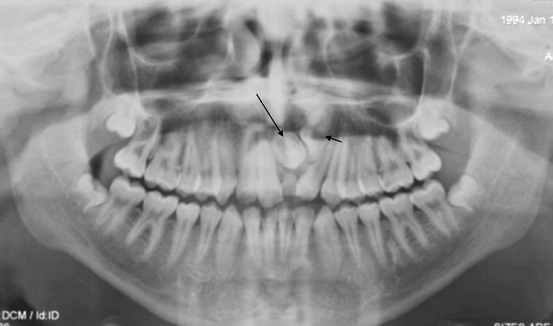

Fig. 3.13
Marked dysmorphic mesiodens (indicated by long arrow) which has impeded the eruption of the median superior left incisor (short arrow)
An error of interpretation can be committed when an inclusive canine tooth with a marked mesiodistal inclination (therefore close to the median line) is confused with a paramedian mesiodens.
In such a scenario, the detection of the correspondent deciduous element turns out to be decisive and clarifying (Fig. 3.14).


Fig. 3.14
The element 2.3 is inclusive and has a mesiodistal inclination (it is indicated by short arrow). This situation must not erroneously be confused with the presence of a mesiodens in paramedian seat. It is known to be an inclusive canine as persistence of the corresponding deciduous element (indicated by long arrow) occurs
The so-called fourth molar is given rise to when supernumerary teeth occur. It is represented by an element with a very variable morphology (it can be a perfect developed tooth or a rudimental and/or hypoplastic tooth germ). It can be variably adjacent to the third molar, and it often has an altered orientation.
The phenomenon seems to be more frequent in the superior arch (Figs. 3.15, 3.16 and 3.17).

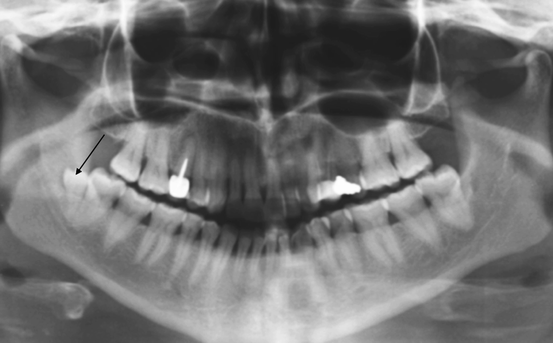
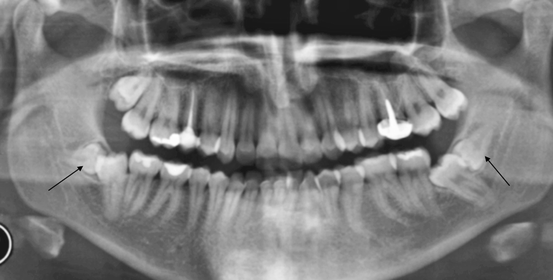

Fig. 3.15
Fourth inclusive and rudimental molar (indicated by arrow)

Fig. 3.16
Inclusive and normally formed fourth molar (indicated by arrow)

Fig. 3.17
Fourth molars which are inclusive, normally formed but with mesiodistal orientation (they are indicated by arrows)
Even if it is characterised by a certain recurrence in its morphological aspects, its classification is always difficult. Indeed, it is not rare to observe unpredictable situations characterised by various complexity (Fig. 3.18).
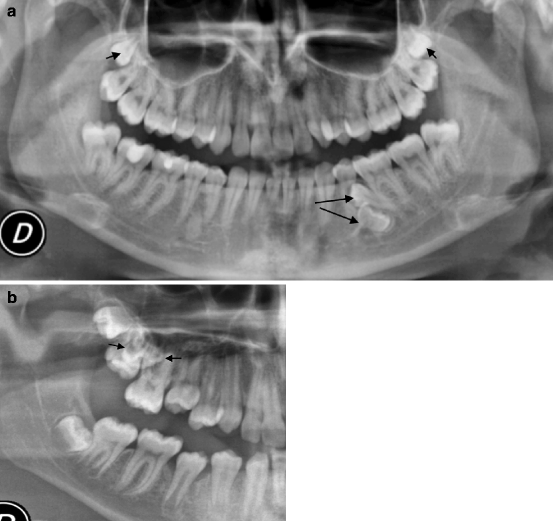

Fig. 3.18
(a) Complex case of supernumerary teeth showing fourth molars in the superior arcade (indicated by short arrows) and two inclusive elements (indicated by long arrows) in the inferior left maxillary, one of which is clearly a supernumerary tooth. (b) Supernumerary rudimental and dysmorphic element (indicated by arrows) which is inclusive between 1.6 and 1.7
The detection of possible supernumerary dental elements only assumes importance if they interfere with the planning of orthodontic and implantological treatments. Moreover, it can represent an obstacle to the correct eruption of the adjacent dental elements (Fig. 3.19
Stay updated, free dental videos. Join our Telegram channel

VIDEdental - Online dental courses


